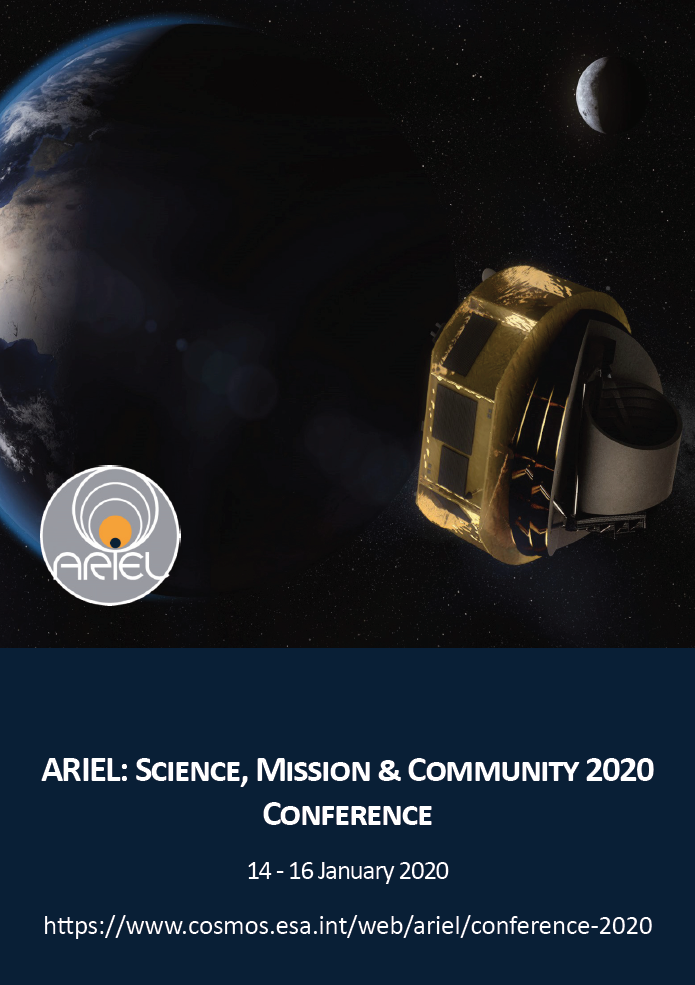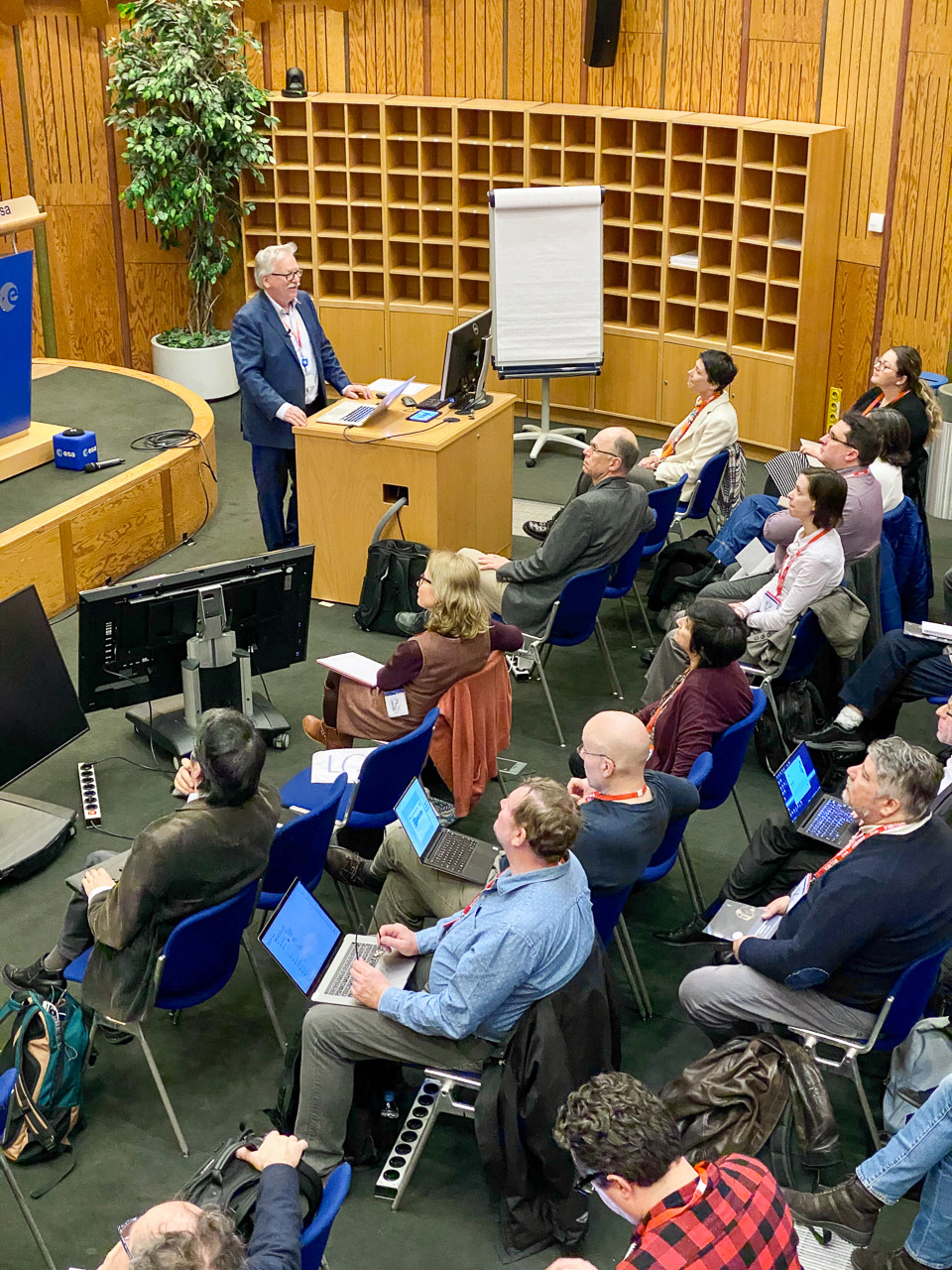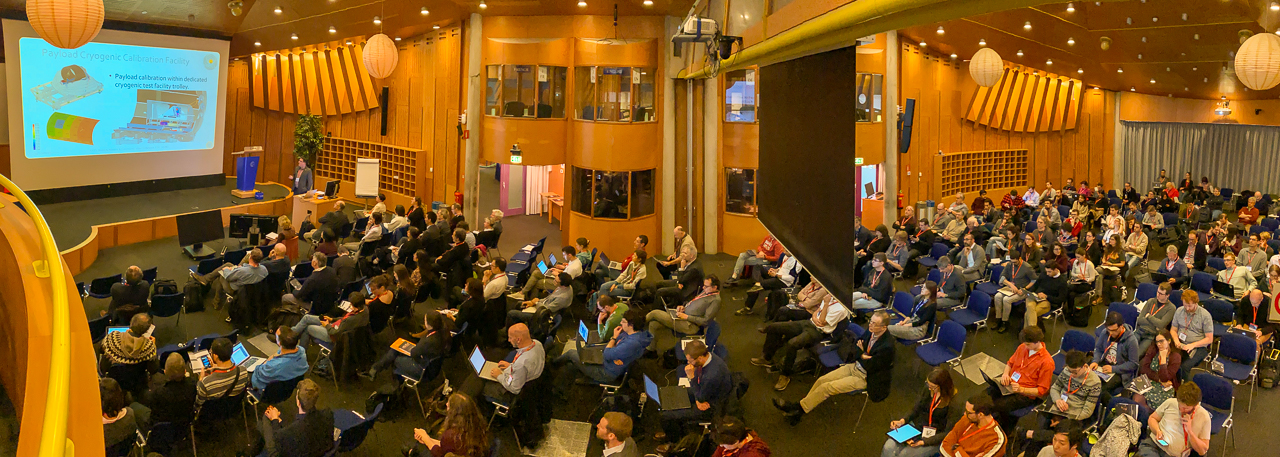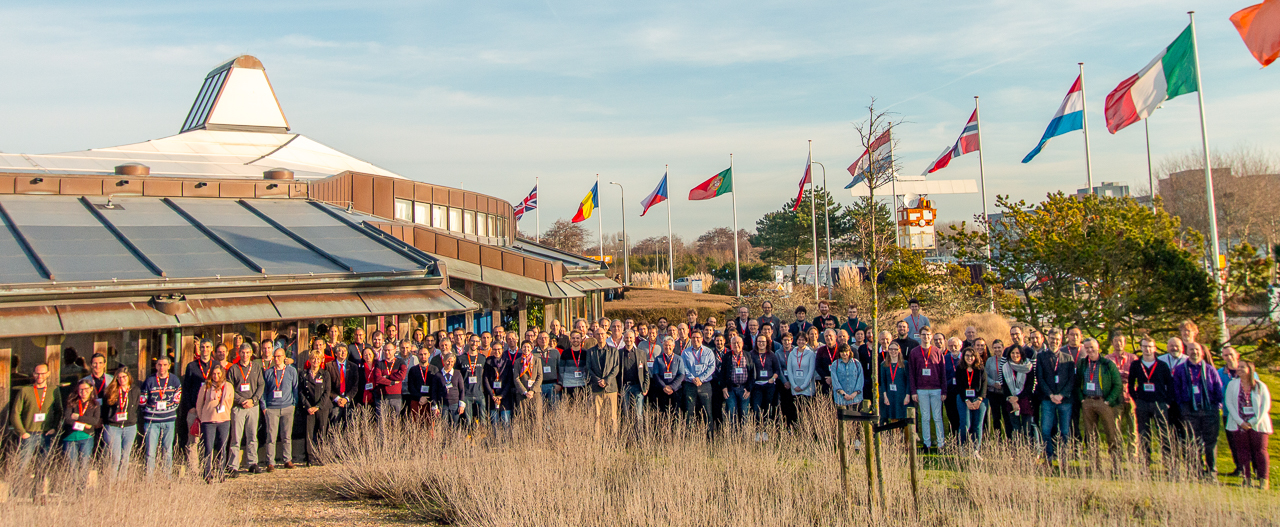ARIEL: Science, Mission & Community 2020 - ARIEL
ARIEL: SCIENCE, MISSION & COMMUNITY 2020
Photos: Bex Coates, UCL
ESA/ESTEC, Noordwijk, THE NETHERLANDS, 14-16 JANUARY 2020
Ariel is the first space mission dedicated to measuring the chemical composition and thermal structures of a large diverse sample of transiting and eclipsing exoplanets, enabling planetary science far beyond the boundaries of the Solar System.
Ariel (then ARIEL) was selected as M4, the fourth medium-sized (M class) mission in ESA's Cosmic Vision Plan, in March 2018. At the time of the conference the mission was in the definition study phase (phase B1), with the next major milestone being mission adoption by the ESA Science Programme Commttee foreseen for November 2020. Ariel has been formally adopted by the SPC on 12 November 2020.
This conference was attended by about 200 participants from 19 countries and had the objectives to:
- Involve the planetary and astrophysical community at large in the mission
- Present the mission and its science as proposed for mission adoption
- Put it into context of other missions and observatories
- Discuss and plan the best ways to promote long term community involvement
WORKSHOP Generalities
- Science programme, talks and posters
- Conference booklet, with abstracts of all contributed presentations
- Conference picture: small - medium - fullsize
- Newton picture: small - medium - fullsize
Talks
14 JANUARY 2020
Welcome, ARIEL Introduction & Overview
- Welcome: ARIEL in Context of ESA Science Program - Günther Hasinger (ESA)
- ARIEL: Mission overview and community participation - Göran Pilbratt (ESA)
- The ARIEL Science Case Outline - Giovanna Tinetti (UCL)
- ARIEL mission status - Ludovic Puig (ESA)
- ARIEL Payload Design Overview - Paul Eccleston (RAL Space)
- ARIEL Performance Modelling and Predictions of Performance - Enzo Pascale (Sapienza)
- The NASA CASE contribution to ARIEL - Mark Swain (JPL)
The ARIEL Target Sample
- The Ariel Mission Reference Sample Target List - Billy Edwards (UCL)
- Results from ALFNOR population study - Lorenzo Mugnai (Sapienza)
- Characterisation of ARIEL host stars - Camilla Danielski (CEA)
- Exoplanet phase-curves with ARIEL - Benjamin Charnay (LESIA)
- Colour-Magnitude Diagrams of Transiting Exoplanets 3: A new tool for the community - Georgina Dransfield (U. Birmingham)
- Exploiting the transit timing capability of ARIEL high-precision photometry - Luca Borsato (U. Padova)
Missions and surveys delivering ARIEL targets
- PLATO Summary - Heike Rauer (DLR)
- Summary of Ground Based Surveys - Don Pollacco (U. Warwick)
- Synergies between radial velocities and the ARIEL mission - Alexandre Santerne (LAM)
- Which planets have atmospheres: the role of photo-evaporation - Vincent Van Eylen (MSSL)
- Synergies between ARIEL and ESPRESSO - María Rosa Zapatero Osorio (CAB)
- MuSCAT1/2/3: Global Multi-Color Photometric Monitoring Network for Exoplanetary Transits - Norio Narita (U. Tokyo)
Poster Previews & Lightning Talks
- Drinks & Poster reception
15 JANUARY 2020
ARIEL Instrumental Capabilities & Data
- ARIEL Telescope Assembly Design Overview - Emanuele Pace (INAF)
- AIRS: The ARIEL InfraRed Spectrometer - Jérôme Amiaux (CEA)
- The ARIEL Fine Guidance System (FGS), Photometer & NIRSpec - Mirosław Rataj (CBK)
- The ARIEL Science Ground Segment and the Instrument Operations and Science Data Centre: Data Flow and Science Products - Chris Pearson (RAL) & Pino Malaguti (INAF)
- ARIEL target scheduling - J.C. Morales (ICE-SIC) & Aymeric Walker-Deemin (CNES)
Discs & Planet Formation
- Diagnosing planet formation with elemental ratios - Mihkel Kama (U. Cambridge)
- Linking exoplanet statistics with giant planet formation - Olja Panic (U. Leeds)
- ARIEL: decoding the secrets of planetary formation - Diego Turrini (INAF-IAPS)
- State of the art of planet formation models - Shigeru Ida (ELSI, Tokyo)
- Inside-Out Planet Formation and ARIEL - Jonathan Tan (U. Chalmers - U. Virginia)
- Planetary systems in stellar clusters - a lesson from Planet Nine? - Hans Rickman (CBK)
- Planet formation and composition around low-mass stars - Yamila Miguel (U. Leiden)
- Planet formation, interior and interaction with the star - Yang Gao (SYSU)
Interiors & connection to atmospheres
- Interiors & the connection to atmospheres - Jérémy Leconte (U. Bordeaux)
- On the Evolution and Internal Structure of Giant Planets - Simon Müller (U. Zurich)
- Atmospheres of Hot Rocky Exoplanets - Yuichi Ito (UCL)
- Exploring Super-Earth Surfaces Albedo of Near-Airless Magma Ocean Planets and Topography - Darius Modirrousta-Galian (INAF)
Atmospheric models & observations
- State of the art – observations of exoplanet atmospheres - Laura Kreidberg (CfA)
- Spectroscopic Phase Curves of Exoplanets in the ARIEL Era - Jean-Michel Désert (U. Amsterdam)
- Understanding the chemical composition of exoplanet atmosphere - Olivia Venot (LISA)
- Atmospheric dynamical models: from solar system planets to exoplanets observed by ARIEL - Aymeric Spiga (LMD)
- Atmospheres in 3D with Ariel - Vivien Parmentier (U. Oxford)
- Lessons learned from IR Solar System Observations - Thierry Fouchet (Paris Obs.)
- Classification of super-Earths and sub-Neptunes with ARIEL Based on the Main Ions in the Thermosphere - Jérémy Bourgalais (LATMOS)
- How known planets from the Solar System would be seen if they were exoplanets - Gabriella Gilli & Pedro Machado (IA Lisboa)
- Exploring disequilibrium chemistry in the atmospheres of hot Jupiters - Yui Kawashima (SRON)
- Geometric albedos of exoplanet day sides at optical wavelengths - Matthias Mallonn (Leibniz Institute Potsdam)
16 JANUARY 2020
Synergies with other missions and observatories
- TESS Discoveries - David Ciardi (Caltech/IPAC)
- Complementarities and Synergies between ARIEL & JWST - Pierre Olivier Lagage (CEA)
- Exoplanet Science with the James Webb Space Telescope - Knicole Colon (NASA Goddard)
- Synergies between ARIEL and the ELTs - Enric Palle (IAC)
- Ariel targets and high-precision photometric support from NGTS - Peter Wheatley (U. Warwick)
- On the synergy between ARIEL and ground-based high-resolution spectroscopy - Gloria Guilluy (INAF)
- CHEOPS - Willi Benz (U. Bern)
- Synergies between ARIEL and Direct Imaging and WFIRST - Anthony Boccaletti (LESIA)
Spectral retrievals & spectroscopic data
- Atmospheric retrieval for the ARIEL spectral database - Michiel Min (SRON)
- Machine Learning in Exoplanet Atmospheric characterisation - Ingo Waldmann (UCL)
- Using model comparisons to understand and overcome challenges in atmospheric retrieval - Joanna Barstow (UCL)
- Exploring the ARIEL Capabilities to Constrain Exoplanet Atmospheres - Patricio Cubillos (Space Research Institute, Graz)
- Self-Consistent Phase Curve Retrieval in the ARIEL Era - Jasmina Blecic (NYUAD)
- The Status of Spectroscopic Data for the ARIEL Mission - Sergey Yurchenko (UCL)
- Infrared spectroscopy of ions, radicals and Rydberg atoms for Ariel astronomy - Svatopluk Civiš (Heyrovský Institute)
Properties of exoplanet host stars & interactions
- Stellar activity and Ariel observations - Giusi Micela (INAF)
- What can the Dispersed Matter Planet Project do for ARIEL? - Carole Haswell (OU)
- Stars shaping the atmospheres of their Planets - Theresa Lueftinger (U. Vienna)
- Stellar flares with ARIEL - Krisztián Vida (Konkoly Obs.)
- Activity model and chromatic effects on transit depths from ground-based multiband photometry - Manuel Perger (ICE-CSIC)
- Direct recovery of planet masses for ARIEL with radial velocities - John Barnes (OU)
Data challenges and community tools
- Overview of ARIEL Machine Learning Data Challenge results - Nikolaos Nikolaou (UCL), given by Ingo Waldmann (UCL)
- Details of MLDC winning team results 1 - James Dawson (remote - mp4 [30 MB])
- Details of MLDC winning team results 2 - Vadim Borisov (remote)
- Details of MLDC winning team results 3 - Artash Nath (remote - mp4 [120 MB])
- ARES, the Ariel Retrieval of Exoplanet Spectra School - Jean-Philippe Beaulieu (IAP)
- ARIEL Data Reduction Challenge - Angelos Tsiaras (UCL)
- The Horizon-2020 ExoplANETS-A project: Advancing transit spectroscopy - Jeroen Bouwman (MPIA)
- The ExoClock Project: Pro-Am collaboration for ground-based observations in support of the ARIEL space mission - Anastasia Kokori (Royal Obs. Greenwich)
POSTERS
Only the posters where either the poster proper or the poster preview have been made available are listed here
- Lorena Acuña (LAM) - Exploring the clearness/cloudiness of the atmospheres of gas giant exoplanets
- Xanthippi Alexoudi (Leibniz Institute for Astrophysics Potsdam) - On the degeneracy of the planetary spectral slope with orbital parameters
- Serena Benatti (INAF - Osservatorio Astronomico di Palermo) - Feasibility of mass determination for ARIEL targets: implications for atmospheric characterization
- Giovanni Bruno (INAF - Catania Astrophysical Observatory) - Activity levels and cycles of the ARIEL stars
- Florian Debras (IRAP, Toulouse) - SPIRou meets ARIEL
- Daria Desiderà (University of Padova) - Exploiting the potential of Low-Resolution spectrophotometry to characterize exoplanetary atmospheres
- Pierre Drossart (LESIA, Observatoire de Paris) - Solar System transit spectroscopic observations: comparison to ARIEL
- Thérèse Encrenaz (LESIA, Observatoire de Paris) - Observability of temperate Jupiters with ARIEL
- Yang Gao (Sun Yat-Sen University) - On the radiation power, burst rate and frequency shift of exoplanetary synchrotron radio bursts
- Mark Jones (The Open University) - Investigating catastrophically disintegrating exoplanets through their vapour trails
- Csaba Kiss (Konkoly Observatory) - Auxiliary science with ARIEL
- Ulrich Kolb (The Open University) - Follow Up of Transiting Hot Jupiters with the OpenScience Observatories
- Mario Morvan (University College London) - Potential of Recurrent Neural Networks for Transit Light Curves detrending
- Athanasia Nikolaou (Sapienza University, Rome) - Thermal evolution of magma oceans and concurrent H2O/CO2 atmosphere formation
- Lisa Nortmann (IAC) - Ground-based high-resolution transit spectroscopy with CARMENES
- Jake Taylor (University of Oxford) - Understanding and Mitigating Biases when Studying Inhomogeneous Emission Spectra
- Removed a total of (3) style text-align:center;
- Removed a total of (1) style text-align:right;
- Removed a total of (1) style overflow:auto;
- Removed a total of (2) style float:left;
- Removed a total of (1) style float:right;
- Removed a total of (3) style margin:0;
- Removed a total of (1) style display:none;
- Converted a total of (1) center to div.








































 Sign in
Sign in
 Science & Technology
Science & Technology



